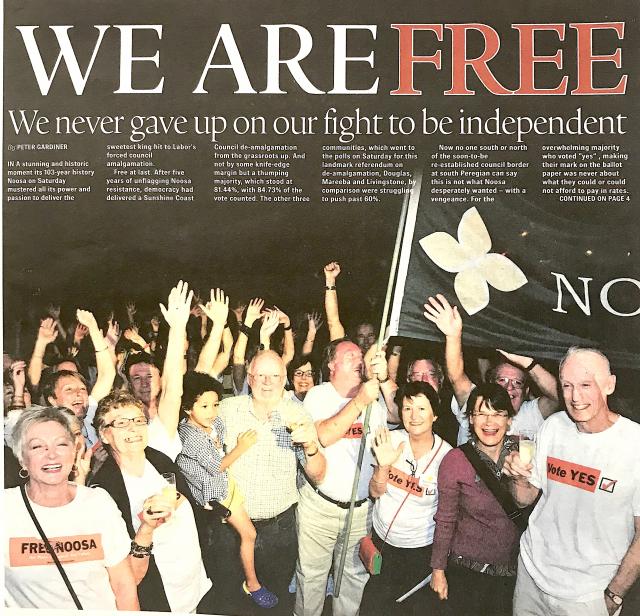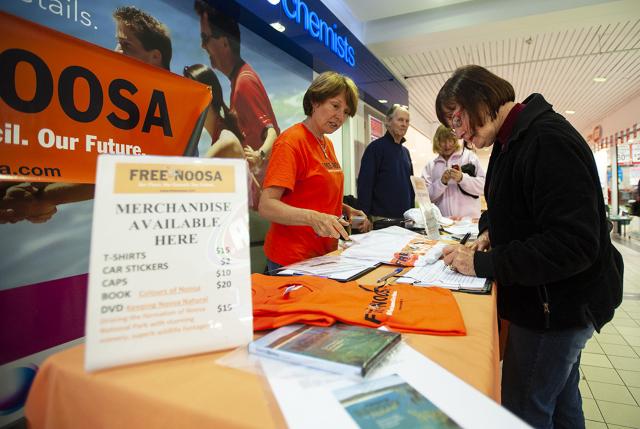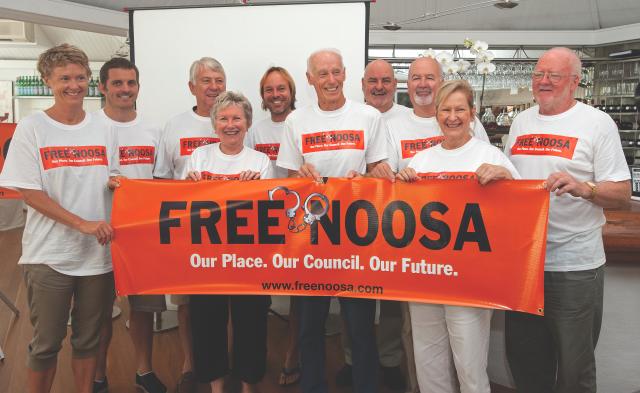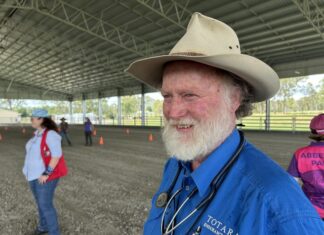The battle for de-amalgamation was waged on three fronts — political, legal and public opinion.
On the political front, Bob Ansett wrote to Prime Minister John Howard requesting the Commonwealth’s support in calling for a new plebiscite in Noosa. With some prodding from the highly respected Warren Truss, federal MP for Wide Bay (which includes Noosa), Howard agreed to fund the plebiscite, and also hold a Senate hearing in Noosa on the forced amalgamations.
Howard was in a tailspin of public opinion ratings, and Queensland was critical to his chances of re-election at the forthcoming federal poll.
The FON’s controversial “Save Noosa Dump Labor” billboard campaign had not gone unnoticed.
Some of the Friends thought this blatant support of the Liberal National Party (LNP) at both state and federal level, was putting the fight too much into the political arena, but it achieved the desired results.
The Howard-funded plebiscite produced a 96 per cent vote in favour of remaining Noosa Shire.
The one-day Senate hearing in Noosaville produced no direct result, but, said Jim Berardo: “I believe it planted a seed with the LNP that would continue to grow.”
And the federal plebiscite result certainly seemed to fire a rocket into the Beattie camp.
Ansett said: “Now Beattie was in a bit of trouble so he came to us and said he’d introduce an iconic places legislation that would protect us from things like high-rise. And he did, but then Anna Bligh took over.”
With the amalgamation set to take effect in March 2008, and new Premier Bligh proving even harder to deal with than Beattie had been, FON looked to its legal options, but in March 2008, the Queensland Government held local elections across the state for the newly amalgamated councils.
Noosa Shire ceased to exist, although the Noosa influence was still felt within the new Sunshine Coast Council, with Bob Abbot winning the mayoral race at a canter and former Noosa councillors Russell Green and Lew Brennan also elected.
Inevitably, with amalgamation a done deal, there was a falling away of membership of FON, some believing that de-amalgamation — a rarity in Australian politics — was just a pipedream, others disheartened by the strongly partisan LNP line that many of the front-liners were taking.
But at FON, the war continued.
FON board member Drew Pearson recalls: “Between 2008 and 2010, I think the feeling was that if either Bob or Jim had lost their enthusiasm, it was game over. The campaign would have died in the arse.”
By 2010, the supporters of de-amalgamation had regrouped and, putting political views and personal grievances aside, the major players, persuaded by Michael Gloster, were able to forge an alliance between the NPA, the Noosa Biosphere Association, the Eumundi, Doonan, Verrierdale Residents Group and, most critically, FON.
Former Noosa mayor, author and historian Tony Wellington wrote: “Having previously engaged closely with both NPA and Friends of Noosa, [I] made the initial appeals … At first the suggestion was viewed with suspicion: the NPA and FON were not natural allies.”
But after further entreaties from Noel Playford, the “muscular collusion of the two largest community organisations”, as Wellington described it, was sealed, and in March 2011, the Noosa Independence Alliance launched its Free Noosa campaign, with every star in the de-amalgamation firmament united behind the orange banners.
The two strongest figures in the de-amalgamation movement — Bob Ansett and Noel Playford — were at last publicly united with an agenda to regain independence.
From the early days of amalgamation, NPA members had used their political networks to initiate quiet approaches to senior Labor figures about the prospects of the Labor government, now led by Anna Bligh, being sympathetic to a comprehensive case for de-amalgamation.
But, says one source, “Like Thatcher, they were not for turning. We started to realise that our only hope was to get an undertaking from the LNP opposition leader to allow us a vote if they defeated the Bligh government at the election in 2012.”
The circuit-breaker in securing the LNP’s public support for a de-amalgamation referendum came just weeks after the launch of the Free Noosa campaign. The LNP, fed up with more than a decade of mundane leadership, parachuted the popular Brisbane Lord Mayor Campbell Newman into the top job, despite the fact that he did not have a seat in the parliament.
Acting on behalf of the Noosa Independence Alliance, Ansett and Elmes were able to get Newman to Noosa for a meeting in early August at which he agreed to support a de-amalgamation referendum.
On 24 March 2012, the Newman-led LNP won 78 seats to Labor’s seven in an historic landslide victory that gave Premier Newman a powerful mandate to carry out his many election promises, including beginning reviewing the disputes over amalgamated councils.
After a six-month review — and the digestion of a massive 140-page report outlining Noosa’s case — the Newman government announced in December 2012 that Noosa and three other former councils would determine their futures by a referendum on 9 March 2013.
The referendum campaign was long and bitter for those who opposed Noosa’s independence, because it was a foregone conclusion, and there’s nothing quite so vicious as a couple of wounded warriors.
On the day, the yes vote was 81 per cent, with a record low in informal votes.
As Tony Wellington noted: “This was a community that was decisively engaged in the decision and apathy was at an all-time low.”
Noosa had its independence back. Finally, it was time to celebrate.
But the process of “de-scrambling the egg” was slow and laborious.
On 9 November 2013, a new Noosa Shire Council was elected, with the experienced Noel Playford as mayor and the equally experienced Bob Abbot as his deputy. Future mayor Tony Wellington was one of six councillors. They had the job ahead of them.
Bob Ansett and Jim Berardo had long since moved off centre-stage and returned to their normal Noosa lives.
People still debate about who did what and how effective it was over those troubled but ultimately victorious times, when the unique qualities of this place came to the fore. And for every name in lights, there had been 100 anonymous volunteers behind them, putting in the hard yards.
Parts of this article were extracted from Place of Shadows, by Phil Jarratt (Boolarong Press, 2021), available from philjarratt.com









